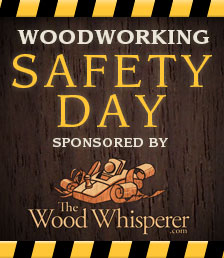Today is Woodworking Safety Day. I have been fortunate through my years of woodworking to only injure myself twice and neither of them was severe. I could go into the detail on those events but you ultimately wouldn’t learn much. However, both of those incidents could have been prevented if I had just followed this advice:
Over the last few decades I have learned a lot of different things. Many of them have been important events in my life: learning to drive, learning to fly, and learning woodworking to name a few. However, those are skills, not behaviors. It is behavior that I found to be the most important lesson in my life – one in particular – and it has helped keep me safe in the shop so far. This behavior is not only applicable in the shop but is truly something that you can use throughout your life. I didn’t really discover it until I was in my late 20’s. I’m talking about listening to the little voice in your head.
As an airline pilot and former fighter pilot I have been trained for decades in the “safety” mentality. I am, at heart, a safety professional. Any new parent knows what that mindset is like – you explore everything in sight for any possible threat to the welfare of this new life form.
Research into aviation accidents shows that the accident chain consists of twenty-two events on average. That’s twenty-two opportunities to break the chain and prevent the accident. In aviation we rely on procedures in order to help break that chain. Using time tested procedures that we know work and work well. We also differentiate between procedure and technique. A procedure is something that must be done in a certain way in order to help ensure a safe outcome. There is no room for creativity with procedures. Technique, on the other hand, is all about creativity – and encouraged as long as it does not conflict with a procedure. There are good techniques and there are bad techniques. Hopefully over time you will filter out your bad ones and keep your good ones.
In aviation there are a whole lot of procedures and very few things left up to personal technique. Woodworking is exactly the opposite – there are very few procedures and a whole lot of techniques. A few procedures that come to mind: wearing safety glasses, wearing hearing protection when using machinery, unplugging your power tool while messing with the business end (changing a router bit for example). There are more but you get the idea. Complying with a procedure will not ensure safety, but non-compliance will most certainly put you at risk.
So, what about all the techniques? Well, that’s where the little voice comes in. We all have it. For years I heard it but didn’t listen to it. I didn’t respect it’s wisdom. I have now learned to listen to it. It KNOWS! As you develop shop techniques that will form your workflow for years to come, listen to the voice. Don’t just hear it. If you’re making a cut and that little voice in your head says “I should probably be using a push stick here.” STOP and get a push stick. If you’re carving and hear that little voice telling you that if the gouge slips it’s going to go right into your other hand. STOP and adjust your grip. Eventually these safety techniques will become procedures for you in your shop.
In both of the incidents I’ve had in the shop I heard the voice, but I didn’t listen to it. I’ve found this to be true of “incidents” in all facets my life. If only I had listened to the little voice! Will listening to the voice guarantee your safety? Absolutely not. But just like procedure, not listening to it will certainly put you at increased risk.
Have a safe day in the shop – every day!


Well written Mark, I enjoyed it. The procedure/technique point is well taken and it does explain a lot of why we get into trouble as we "create". Regarding the little voice in your head, what do you do when there is more than one? Moreover what if they conflict with one another and NEVER shut up! Wait…did I just share too much?
LikeLike
In those cases I try to just listen to the woman with the sexy british accent. I hope you have one of those!
LikeLike
I agree with Shannon, Mark, very well written. As a 20-year Navy vet, I know all too well about the importance of safety. After transitioning to the civilian world, I realized that companies don’t necessarily follow the same guidelines concerning safety. My first job after retiring basically paid lip-service to the the idea…kind of a "Do as I say, not as I do" policy. However, the job I’m currently in takes it very seriously.
I’m currently in the process of getting a new table saw because the old one is no longer safe (long story). I also inherited my Dad’s Shopsmith, which is severely lacking any safety devices, so refuse to turn that beast on until I can get it safe.
I have heard and listened to that "little voice" on many occasions. Sometimes I ignore it, but most of the time I listen. I have yet to have a major accident, but that doesn’t mean that it won’t happen sometime in the future.
BTW, I came here through Tom’s Workbench. I look forward to hearing and seeing what you have to offer.
John WolfeSanger, Texas
LikeLike
Thanks for reading John. Fortunately my company takes safety very seriously. In fact it is our #1 corporate priority. Let me know what table saw you decide on. I spent some time the other day on the phone with the CPSC to see where they stood on their proposal of requiring flesh sensing technology for table saws. They have now partnered with UL to do some research on approach speeds and depth of cut mitigation requirements. The person I spoke said that they had consulted with a prominent hand surgeon and that based on his input they were going with a requirement for a depth of cut not more than 3mm. They also said there were several manufacturers working on technology to compete with SawStop. From the sound of it the time frame to see those products on the market would probably be 3-5 years from now.
LikeLike